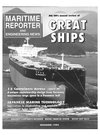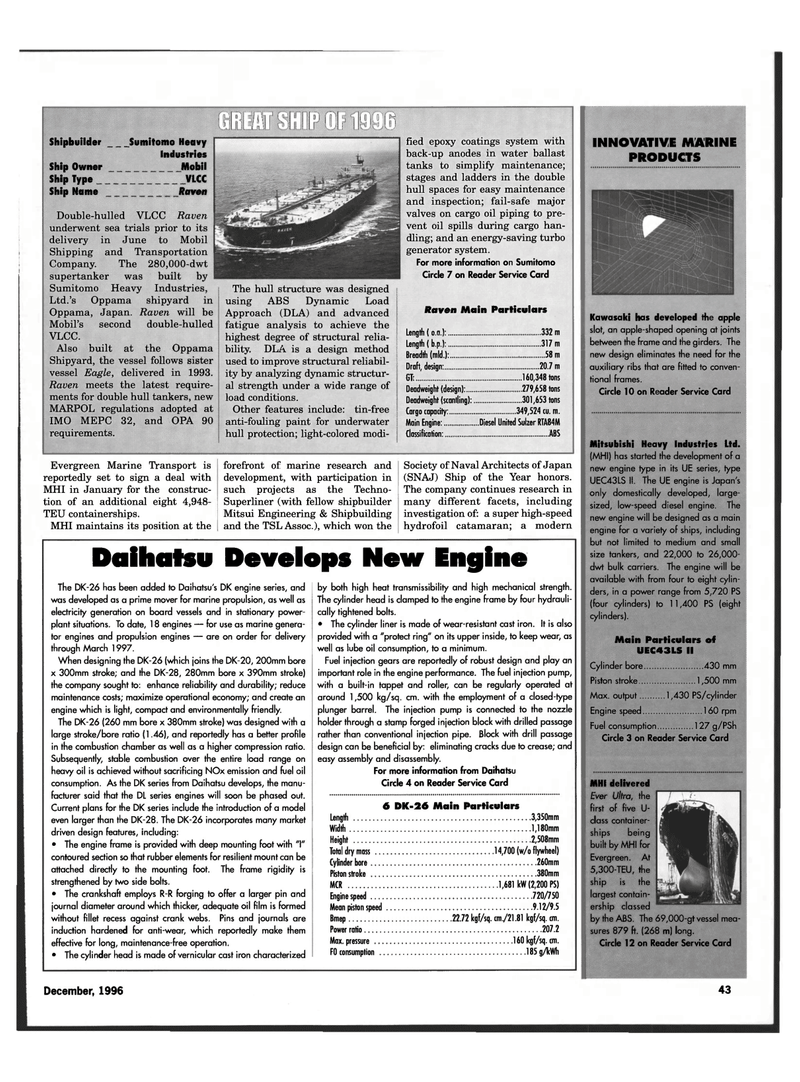
Page 41: of Maritime Reporter Magazine (December 1996)
Read this page in Pdf, Flash or Html5 edition of December 1996 Maritime Reporter Magazine
The hull structure was designed using ABS Dynamic Load
Approach (DLA) and advanced fatigue analysis to achieve the highest degree of structural relia- bility DLA is a design method used to improve structural reliabil- ity by analyzing dynamic structur- al strength under a wide range of load conditions.
Other features include: tin-free anti-fouling paint for underwater hull protection; light-colored modi- fied epoxy coatings system with back-up anodes in water ballast tanks to simplify maintenance; stages and ladders in the double hull spaces for easy maintenance and inspection; fail-safe major valves on cargo oil piping to pre- vent oil spills during cargo han- dling; and an energy-saving turbo generator system.
For more information on Sumitomo
Circle 7 on Reader Service Card
Raven Main Particulars
Length ( o.a.): 332 m
Length (b.p.): 317 m
Breadth (mid.): 58 m
Draft, design: 20.7 m
GT: 160,348 tons
Deadweight (design): 279,658 tons
Deadweight (scantling): 301,653 tons
Cargo capacity: 349,524 cu. m.
Main Engine: Diesel United Sulzer RTA84M
Classification: ABS
Shipbuilder Sumitomo Heavy
Industries
Ship Owner Mobil
Ship Type VLCC
Ship Name Raven
Double-hulled VLCC Raven underwent sea trials prior to its delivery in June to Mobil
Shipping and Transportation
Company. The 280,000-dwt supertanker was built by
Sumitomo Heavy Industries,
Ltd.'s Oppama shipyard in
Oppama, Japan. Raven will be
Mobil's second double-hulled
VLCC.
Also built at the Oppama
Shipyard, the vessel follows sister vessel Eagle, delivered in 1993.
Raven meets the latest require- ments for double hull tankers, new
MARPOL regulations adopted at
IMO MEPC 32, and OPA 90 requirements.
Evergreen Marine Transport is reportedly set to sign a deal with
MHI in January for the construc- tion of an additional eight 4,948-
TEU containerships.
MHI maintains its position at the forefront of marine research and development, with participation in such projects as the Techno-
Superliner (with fellow shipbuilder
Mitsui Engineering & Shipbuilding and the TSL Assoc.), which won the
Society of Naval Architects of Japan (SNAJ) Ship of the Year honors.
The company continues research in many different facets, including investigation of: a super high-speed hydrofoil catamaran; a modern
Daihatsu Develops New Engine
The DK-26 has been added to Daihatsu's DK engine series, and was developed as a prime mover for marine propulsion, as well as electricity generation on board vessels and in stationary power- plant situations. To date, 18 engines — for use as marine genera- tor engines and propulsion engines — are on order for delivery through March 1997.
When designing the DK-26 (which joins the DK-20, 200mm bore x 300mm stroke; and the DK-28, 280mm bore x 390mm stroke) the company sought to: enhance reliability and durability; reduce maintenance costs; maximize operational economy; and create an engine which is light, compact and environmentally friendly.
The DK-26 (260 mm bore x 380mm stroke) was designed with a large stroke/bore ratio (1.46), and reportedly has a better profile in the combustion chamber as well as a higher compression ratio.
Subsequently, stable combustion over the entire load range on heavy oil is achieved without sacrificing NOx emission and fuel oil consumption. As the DK series from Daihatsu develops, the manu- facturer said that the DL series engines will soon be phased out.
Current plans for the DK series include the introduction of a model even larger than the DK-28. The DK-26 incorporates many market driven design features, including: • The engine frame is provided with deep mounting foot with "I" contoured section so that rubber elements for resilient mount can be attached directly to the mounting foot. The frame rigidity is strengthened by two side bolts. • The crankshaft employs R-R forging to offer a larger pin and journal diameter around which thicker, adequate oil film is formed without fillet recess against crank webs. Pins and journals are induction hardened for anti-wear, which reportedly make them effective for long, maintenance-free operation. • The cylinder head is made of vernicular cast iron characterized by both high heat transmissibility and high mechanical strength.
The cylinder head is clamped to the engine frame by four hydrauli- cally tightened bolts. • The cylinder liner is made of wear-resistant cast iron. It is also provided with a "protect ring" on its upper inside, to keep wear, as well as lube oil consumption, to a minimum.
Fuel injection gears are reportedly of robust design and play an important role in the engine performance. The fuel injection pump, with a built-in tappet and roller, can be regularly operated at around 1,500 kg/sq. cm. with the employment of a closed-type plunger barrel. The injection pump is connected to the nozzle holder through a stamp forged injection block with drilled passage rather than conventional injection pipe. Block with drill passage design can be beneficial by: eliminating cracks due to crease; and easy assembly and disassembly.
For more information from Daihatsu
Circle 4 on Reader Service Card 6 DK-26 Main Particulars
Length 3,350mm
Width 1,180m
Height 2,508m
Total dry mass 14,700 (w/o flywheel)
Cylinder bore 260mm
Piston stroke 380m
MCR 1,681 kW (2,200 PS)
Engine speed 720/750
Mean piston speed 9.12/9.5
Bmep 22.72 kgf/sq. cm./21.81 kgf/sq. cm.
Power ratio 207.2
Max. pressure 160 kgf/sq. cm.
F0 consumption 185gAWh
INNOVATIVE MARINE
PRODUCTS
Kawasaki has developed the apple slot, an apple-shaped opening at joints between the frame and the girders. The new design eliminates the need for the auxiliary ribs that are fitted to conven- tional frames.
Circle 10 on Reader Service Card
Mitsubishi Heavy Industries Ltd. (MHI) has started the development of a new engine type in its UE series, type
UEC43LS II. The UE engine is Japan's only domestically developed, large- sized, low-speed diesel engine. The new engine will be designed as a main engine for a variety of ships, including but not limited to medium and small size tankers, and 22,000 to 26,000- dwt bulk carriers. The engine will be available with from four to eight cylin- ders, in a power range from 5,720 PS (four cylinders) to 11,400 PS (eight cylinders).
Main Particulars of
UEC43LS II
Cylinder bore 430 mm
Piston stroke 1,500 mm
Max. output 1,430 PS/cylinder
Engine speed 160 rpm
Fuel consumption 127 g/PSh
Circle 3 on Reader Service Card
MHI delivered
Ever Ultra, the first of five U- class container- ships being built by MHI for
Evergreen. At 5,300-TEU, the ship is the largest contain- ership classed by the ABS. The 69,000-gt vessel mea- sures 879 ft. (268 m) long.
Circle 12 on Reader Service Card
December, 1996 43

 40
40

 42
42
